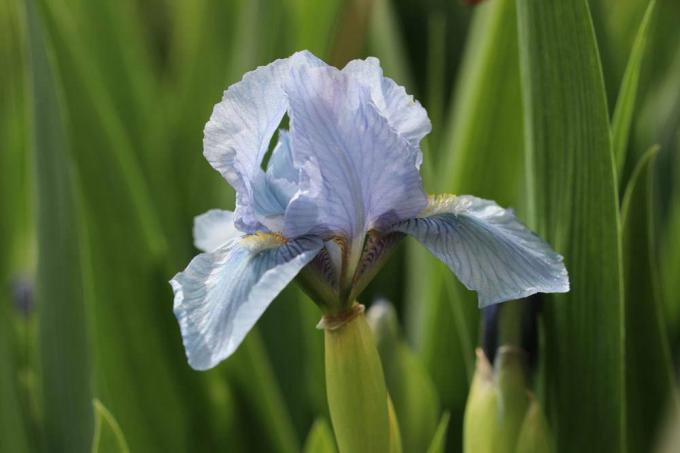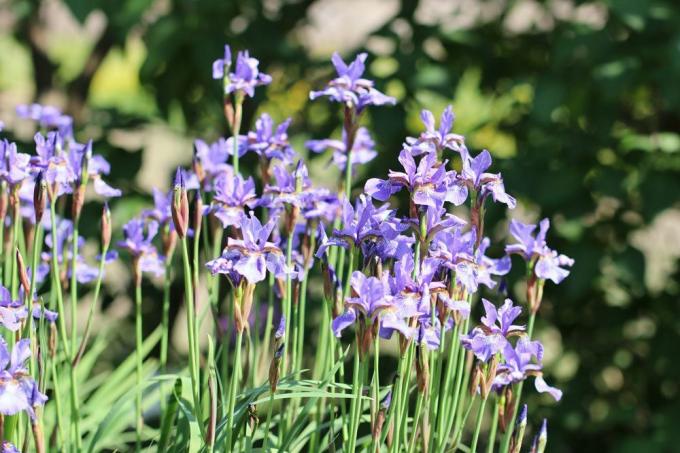
table of contents
- Planting irises
- Location
- Planting irises: instructions
- Plant spacing
- Best planting time
The iris (iris) is one of the most diverse garden perennials in view of the numerous variations. With their filigree flowers, they are a treat for the eyes. A distinction is made between rhizome and onion iris. While a rhizomiris forms an underground stem axis system (rhizome), the persistence organs of the onion iris consist of tubers, which are incorrectly referred to as onions. It grows in the garden bed or as a swamp and water inhabitant. As a result, there are a few things to consider when planting the iris.
Planting irises
There are a few things to consider when planting iris. In the following article you will find out everything about planting irises: From the correct planting distance to the perfect time.
Location
- prefers sunny to light-shaded locations protected from the wind
- Shouldn't be exposed to the sun all the time
- Especially not the blazing midday sun
- It is best to have about six to eight hours of sun a day
- Beard, steppe and small reticulated irises are heat-loving species
- Most rhizome and onion irises are sensitive to moisture and moisture
- As a result, increased planting is an advantage
- For example on a slope or in a raised bed
- Ensures better water drainage
- With the exception of the beardless meadow and swamp irises
- Put meadow iris in fresh to moist places
- Swamp iris needs swampy to wet locations
- pH value rather weakly acidic than too lime-rich
- Swamp iris thrives best in water depths of up to 20 cm
- Also tolerates depths of up to 40 cm
- Then usually fewer flowers
With the exception of the moisture-loving irises, the others need a loose, well-drained, sandy / loamy or clay-rich or stony as well as calcareous soil. In soil that is too heavy, plenty of sand, humus or compost should be worked in before planting in order to improve its permeability. Once the soil in the planting area has been thoroughly loosened, all soil obstacles such as root remains, stones and weeds are removed. Now it is optimally prepared, it can be planted.

tip: If one loosens the earth occasionally with a digging fork, this benefits the plant growth. However, you should be careful not to damage the sensitive roots.
Planting irises: instructions
Onion iris
Before planting, it is advisable to sprinkle some horn meal. Then, as a rule, additional fertilization can be dispensed with. Fresh manure and artificial fertilizers should be avoided, they are poorly tolerated by these plants. To plant the onions, first dig small holes about five to ten centimeters deep, depending on the size of the onion. There you put the onions, if necessary on a thin layer of sand. Then you cover them with earth and press them lightly. Finally, the whole thing is watered.
tip: The bulbs should be stored in a cool, dry place until they are planted.
Rhizomiris
The soil loosened up to a depth of 20 cm is first mixed with something compost. Then you shorten the roots to about a hand's breadth. The leaves are also cut in half to reduce evaporation. Then you dig large planting holes corresponding to the rhizome. They are inserted so deep that about a third of it peeks out of the earth, because the rhizome needs contact with light and air to prevent it from rotting. After you have pressed the earth, you still pour on, but not too much.
tip: In particularly hot regions, it can make sense to cover the rhizome with a layer of soil that is a maximum of 2.5 cm thick. Otherwise it could dry out easily.
Swamp sword lily
As already mentioned, the swamp sword lily prefers damp to wet locations, ideally in a water depth between ten and twenty centimeters. This can be in a swamp bed, a wet zone and at the edge of a pond as well as in an artificially created one Stream. If you want to prevent irises from spreading too much, you should put them in a special plant basket.
You first line it with a fleece and then fill it with commercially available bog soil. The iris is placed there and the substrate is weighed down with small stones to prevent the earth from being washed out. Finally, you put them and their basket into the water at the appropriate depth. Of course, the distance between the individual plants also plays a key role.
tip: In order for the swamp lily to thrive optimally, it needs a portion of humus every spring.
Plant spacing
- Planting spacing of irises depends on the variety
- For tall varieties, such as the tall bearded iris, a planting distance of 40 cm
- About five to seven plants per square meter
- Medium-sized varieties, planting a distance of about 30 cm
- For low-growing species approx. 25 cm
- Or 12 to 16 pieces per square meter
- If possible, do not plant the iris too densely
- Otherwise they could grow into each other after a few years
- Competition in terms of water, nutrients and soil would be the result
- inhibited growth of the plants
- Swamp irises need a distance of 40 to 50 cm
- They come into their own in small tuffs from up to six specimens
tip: If flowering subsides after a few years, it is advisable to divide larger pieces of rhizome. You should make sure that each section has roots and a well-developed tuft of leaves.
Best planting time
Similar to crocuses and daffodils, the best time to plant an onion iris is in late summer or early autumn, i.e. in September or October. Planting is also possible in November or in spring, around March. Specimens that you want to cultivate in pots do not require a special time, they can usually be planted all year round. However, irises usually do not do well in pots.
Planting in late summer or early autumn is ideal, then the iris has the chance to form and grow sufficient roots by the first frost. In addition, there is still enough sunlight to support the growth of the iris, which in turn makes it easier for it to hibernate. In contrast, the marsh sword lily has the best starting conditions if you plant it between July and September. If you missed the right time, you should wait until spring, around April / May.




